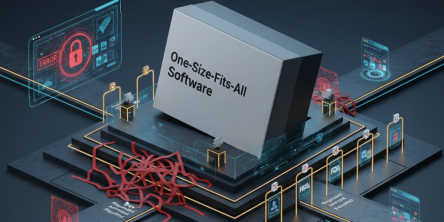How to Transform into a Digital Enterprise Successfully

Recent research published by the MIT Center for Digital Business revealed that in comparison to the industry average, digitally progressive and forward-thinking companies:
- Generated a 9% increase in revenue from employees and assets
- Enjoyed 26% more profits
- Witnessed a 12% increase in their stock value
This makes it pretty evident that no industry or enterprise is immune to the disruptive impact of digitalization. However, initiating a digital transformation is one thing, and doing it successfully is another. So, if you too are taking the digital leap, this article will walk you through the fundamentals of digital transformation, challenges faced during the transition, and the key elements of a structured approach that ensures sustainable success.
The Key Elements of a Digital Transformation of Enterprises
Today, every enterprise that wants to become a market leader with a technological edge needs to embark on a digital transformation journey that entails:
- Alignment Between Business & IT Teams: To unlock optimal digital value, IT and business teams need to work in close collaboration with a clear understanding of each other’s roles and responsibilities. Clarity on how their work impacts the bigger picture based on unique business needs is also essential. Once everyone is committed to the common goal and willing to revamp the way things are done, the organization can move quickly. All of this needs to be supported by a future-ready infrastructure and processes facilitated by an agile approach. Once all of this is happening, the enterprise starts to see the results of digital transformation.
- The pace of Innovation: To accelerate the pace of innovation, enterprises need a composable architecture that comprises 3 crucial layers. The fundamental layer underpins the complete architecture, with a single source of data and continuous integration/continuous delivery (CI/CD) pipeline to automate the delivery of software solutions. The second layer facilitates containerization and deployment in sync with the cloud service provider. The next layer enables the infrastructure to onboard new applications and upgrades for the existing ones. This is where the routine workflows, functional apps, and business processes are executed with custom logic. It connects key business applications to the rest of the enterprises.
- Talent & Enterprise: The third key element of a successful digital transformation is its talent. How an enterprise invests in the training and upskilling of its talent determines how comfortably they can work in an agile environment on cloud-native architectures. Uninterrupted communication and leadership support are non-negotiable at this stage. Even with the right approach in place, companies can still face obstacles in realizing their vision. But, with an experienced technology partner and cloud adoption, organizations can move fast to make the most of their cloud-native architectures and quickly enter into the full-stack development era.
Challenges Faced During Digital Transformation of Enterprises
Many enterprises are yet to realize the advantages they expect and want from their digital transformation. This is due to common bottlenecks like lack of relevant skills, slow project implementation, lack of technical know-how, and fragmented data flowing in from disparate sources. Let’s take a look at some major challenges and ways to overcome them.
- Digital transformation hinges on a commitment to transform talent, skill sets, leadership, and business models. To realize the targeted value from digitalization, CIOs & CTOs must take the time to thoroughly understand the transformation journey and the technologies powering it.
- Digital transformation of enterprises entails a complete overhaul of the organizational culture and structure. This is the best way to drive technology and insights at speed, as and when they’re needed.
- Apart from the mindset, the human element is another big challenge. While talent transformation is equally crucial, it is often overlooked. Legacy talent is aversive to change and difficult to bring up to speed. At the same time, new progressive talent needs to be pooled in.
- The next big challenge is moving an agile model of constant deployment while ensuring that talent across the board is comfortable working with the new structure.
- Another major hurdle is the organization’s technology stack that is powered by legacy architectures that keep it from leveraging the massive potential of the cloud. If that is not addressed, the transition cannot take place at the pace that is so crucial today.
Enterprises that can successfully overcome these challenges will transform into a truly innovative business that is well-positioned to meet consumer expectations, optimize operations & drive down costs.
Core Principles of a Structured Approach
- Focus on the Why – It must convey why the digital transformation must take place and the advantages it will bring to your business.
- Chalk out communication journeys - Bring your teams with you by keeping them informed consistently and constructively.
- Create conducive experiences - Know what your teams need to perform their jobs more efficiently and provide them the needed training, resources, and support.
- Keep everyone on the same page - Make sure everyone is aware of the context and how it relates to their roles, business needs, and the agenda of digital transformation.
- Use data to track metrics and optimize - Continuously monitor the progress and evaluate the results to adapt and evolve as needed.
- Become a future-ready enterprise - it is important to embrace and embed an agile mindset so your people and processes can change at speed.
A successful digital enterprise aligns and updates its people, processes, tools, and technologies as mentioned above. As businesses adapt to the next normal, leveraging the experience and expertise of a top-rated technology partner will be key in bridging the gap between digitalization and ROI.
Similar Articles
Not long ago, the idea of multiple AI agents working together, each with a specific role, collaborating to solve problems, felt like science fiction.
In today’s data-driven world, choosing the right business intelligence (BI) platform can make or break your organization's analytics success.
We all know that companies today are no longer limited to a single physical location. Work processes are also no longer strictly isolated.
It is neither secret nor news that the mind-boggling pace of digital transformation around us has totally altered consumer expectations.
In the world of finance, speed and accuracy are everything. Decisions made a day late can cost millions, and delayed visibility into financial performance can leave even the best organizations blind to risks.
Discover the best tools to enhance employee recognition, boost morale, and create a more motivated, engaged workplace culture.
At first glance, off-the-shelf software appears to be a dream come true. They are quick to set up, cheaper upfront, and marketed as “universal.”
A modern business must continually adapt. This bit everyone seems to know.
The modern healthcare industry is undergoing a significant transformation. The models of healthcare that we are used to thus far are now making way for a more data driven approach









